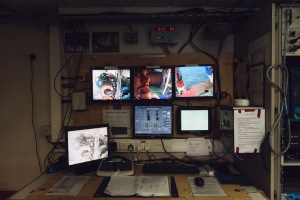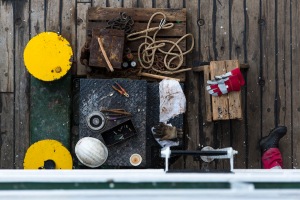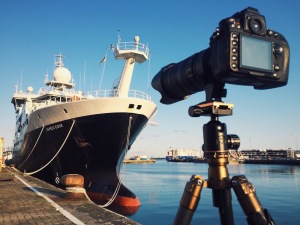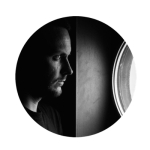A series of guest blogs by Alex Ingle, resident filmmaker and photographer.

As we’re now on a long transit/survey over Dogger Bank, I thought I’d use this time to give you an impression of the ship from the bridge right down to the engine rooms. It would probably be logical to start from the top and work down, but as I’m just about to go and grab a coffee and a bite to eat I think we’ll start in the galley.
When I joined the James Cook for the first Britice-Chrono cruise, I think one of the biggest surprises (definitely the most pleasant!) was just how good the food was and the tremendous effort that goes into making sure everyone is catered for day and night. The guys in the galley are great, the team work hard to make sure nobody goes hungry. I’ve spent quite a lot of time behind the scenes here, learning about their work, picking up some culinary tips and having a snoop around the storerooms.
The most interesting time I spent here was during a really rough patch of weather on the previous Britice cruise. There was a pretty high swell as the tail end of a hurricane hit us, and I was up in the galley with Head Chef John and his team. You might assume that being out on deck is the most dangerous place to be in rough seas, but when the ship’s being tossed around in a storm, and there’s pans of boiling soup, sharp knives and sizzling hot plates here there and everywhere – the galley can be one of the more intense places to work. Unlike the aft deck, which, in the worst weather, might get closed off, the galley team’s work never stops. Everyone relies on these guys.
If you wander down the ship’s corridors towards the ‘Forecastle’ deck, and keep heading up the stairs you’ll reach the bridge. As one of the most advanced research vessels currently in service it’s no surprise that stepping onto the bridge feels like you’re walking onto a Star Trek set… especially at night.
The Captain and his officers oversee all operations from up here, with each decision and observation made out on deck or in the labs being relayed to the bridge deck via radio. The views from up here are fantastic, and it’s by far the best vantage point for spotting wildlife. For that reason, it’s where the Marine Mammal Observer (MMO), Marian, also spends most of her time. She’s got the somewhat enviable task of keeping lookout for any marine mammals and conducting surveys to ensure their protection. In my downtime it’s nice to do some wildlife spotting, and Marian is always the best person to go to for the latest updates.
Above the bridge, up a very steep set of stairs, is one of my favourite spots on the ship. There’s a small deck which holds some of the ship’s radio masts, and it’s just about the highest point I can get to with my camera gear. It gives you an excellent vantage point for the ‘vibrocorer’ on the aft deck, and it offers panoramic views of the ocean. I came up here one night recently during fantastically clear skies and saw two shooting stars… pretty impressive stuff.
Head back down a few flights of stairs, take a few turns here and there down to the science bunks, and wander through an inconspicuous door or two and you’ll find yourself in the engine control room.
The engine room is a fascinating place for me; when you’re up on deck it’s very easy to forget what’s down here in the belly of the ship. It’s an incredibly loud place with machinery everywhere, you need to duck and skirt around pipes, and navigate through watertight doors everywhere you go, and there’s the ubiquitous smell of diesel. There are no portholes and it’s quite disorientating when the sea is rough; it’s an assault on the senses, but a photographer’s paradise!
Of course, it’s a really dangerous part of the ship that demands utmost care. I feel privileged being allowed to explore down here, but as I mentioned before – with noise cancelling earmuffs and camera gear in hand, it’s a tricky place for me to work. Before you’re allowed to set sail, you need to attend a safety briefing and by far the most harrowing pieces of equipment for all visitors are the watertight doors. They are extremely heavy mechanical doors that are used to prevent flooding from one part of the ship to the other in case of an emergency. During your briefing you see various gory images of accidents involving these doors – you operate them with a lever and they move pretty slowly, but you most certainly don’t want to take any risks when stepping through them! I find most visitors (including myself) try to avoid using them where they can, but down in the engine rooms they’re a necessity. I’ve become pretty used to them now, but I have to admit the hairs on the back of my neck still tingle when I have to put my arm through to hold the lever as I step through these automatically-closing doors.
Heading back up a few flights of stairs, past the science teams cutting and analyzing cores in the ‘wet lab’ and through the ‘hanger’ and you’re on the aft deck. This is where I spend the majority of my time, trying to capture images in the heart of the action.
This is where all of the ‘hands on’ science happens. Here the crew, the British Geological Survey (BGS) engineers and the science teams work together to operate the ‘vibrocorer’ and ‘piston corer’, which are lowered into the sea to retrieve samples from the ocean floor. It’s another fascinating area for photography, and it’s a great feeling standing out here in the bracing sea air as seabirds fly past.
I’m out here a lot, straddling different shifts at different times to capture a true picture of life on deck. As soon as night falls, it becomes a totally changed place. Floodlights light the deck, illuminating seagulls in the darkness as they speed past. As the ship bobs up and down, and there’s darkness as far as the eye can sea, looking over the side is quite an eerie but humbling experience. You try not to think about ‘what if’ but inevitably end up considering how different it would be out there compared to a well lit and pleasantly warm swimming pool where you do your marine survival training.
Activity on the aft deck, much like the rest of the ship, revolves around the scientific operations. It’s a hive of activity once we’re about to deploy/retrieve the corers; teams appear from every corner of the ship and it’s all go, but during transits between sites it can become really quite deserted. The crew return inside, the BGS engineers disappear into containers to service equipment, and the science teams head to the labs. There’s a very set routine on board, and it’s really interesting being able to observe it – at times, especially during longer transits, there might only one person left on deck… and that’s usually the lone photographer!
Of course, the quietness is always short-lived and before you know it, the crew reappear, ready to redeploy. One thing that strikes me about everyone on board, especially the crew, is the importance of positivity. A good sense of humour is a key attribute for anyone working at sea. When you’re living in a confined space, working in a hazardous and strenuous environment with the same people, day in day out for weeks or months at a time, humour diffuses tensions, passes the time and helps teams work together. That means there’s always a lot of good ‘banter’ out on deck, and for days when humour doesn’t quite cut it, there was always the punch bag hanging in one of the storerooms!

When the gym is too busy, or when rowing and running just won’t cut it, there’s always the punch bag.
Now to where the science happens – the ship’s labs. Head back in from the aft deck, through the hanger, and the first of these is the ‘wet lab’. Where fresh cores are processed.
Head through there and down a corridor and you’ll reach the ‘dry labs’ where banks of computers and geophysical equipment are being studied meticulously, and, if you time it right, there’s usually a slab of Toblerone or a packed of Haribo being shared around…!
Before I wrap this up, I should point out that one of the reasons I love what I do is my clientele. Scientists (at least the ones I’ve met) tend to be very positive, welcoming and down to earth people, so it’s a pleasure dealing with them on a day-to-day basis.
One reason why this area of photography/filmmaking was a natural progression for me, is it followed on from my own scientific background. Having studied glaciers in Iceland and Greenland during undergrad and postgrad research, I have a fairly broad understanding of a lot of the topics that the Britice-Chrono team are investigating. This is essential for knowing when and where to shoot, and definitely helps me understand the teams’ enthusiasm for mud!
Connect with Alex on social media:
Instagram: @alexinglephoto
Twitter: @alexinglephoto
Facebook: http://facebook.com/alexinglephoto








































